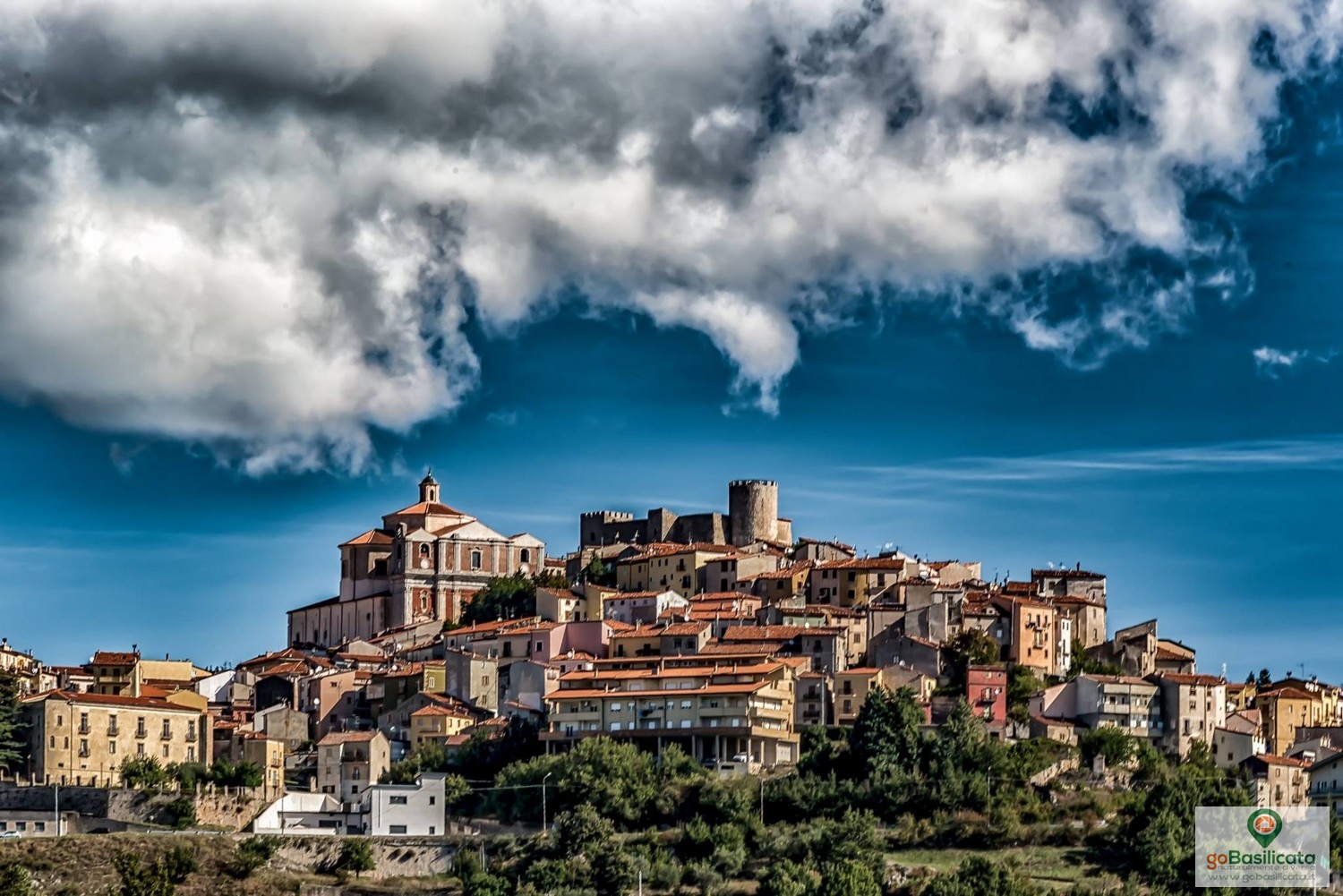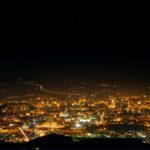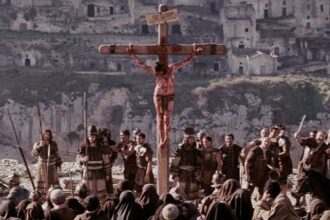Moliterno it is a splendid village in the upper Agri Valley, rich in history, tradition and culture, included in the Lucanian Apennine National Park Val d'Agri LagonegreseIn the alleys of the historic center you can smell the renowned Canestrato PGI, which is aged in the characteristic “fòndaci”.
“The big village”, as the inhabitants usually call it Moliterno, develops around the medieval castleFrom here, alleys and streets branch off, where it's easy to come across historic noble palaces and ancient stone houses.
The origins of the oldest part of the town, the rocky spur around the castle, are linked to the Lucanian Samnite populations. The village was later repopulated by survivors of the destruction of "Grumentum” and dominated by the Normans who built the castle. Subsequently Moliterno came under the domination of the Swabians first, then some Angevins and of the Aragonese who ceded the fief to Antonio Sanseverino, Prince of Salerno.
There are several things to see in Moliterno: we've compiled a list to help you choose the best things to do in this charming village in the Agri Valley.
1 Moliterno Castle
Without a doubt the symbol and main attraction of Moliterno it is the Castle, around which the rest of the historic center developed. The first nucleus of the structure to be built was the Lombard watchtower, 25 meters high. The castle was later completed by the Normans and transformed several times over the centuries by successive rulers. The surrounding walls and two crenellated cylindrical towers are still visible today.

The churches of Moliterno
2 Mother Church of Santa Maria Assunta
Built around the 12th century and located under the castle, the Mother Church of Santa Maria Assunta of Moliterno It is the main church of the town in the Val d'Agri. The interior has three naves with a dome dating back to 1754, while the façade was completed only in 1885 and is flanked by two unfinished bell towers. The church houses a baptistery from 1617, a painting of Saint Peter attributed to Simone from Florence (16th century), a large canvas from the Neapolitan school depicting theLast supper (17th century) and four papier-mâché busts of evangelists (18th century).

3 Church of the Rosary
The Dominican Church of the Rosary It was built in 1510 for the convent of the Dominicans, enlarged in 1616 and renovated in 1666. Inside you can admire the frescoes on the vaults of the naves and several other works of notable value, including a valuable wooden choir from 1543 and a pipe organ by the renowned company CarelliOf the ancient monastery, the cloister can be recognised, with the central well and the fresco with Christ and the Magdalene of the 17th century.

4 Church of Santa Croce
Another noteworthy place of Moliterno It is undoubtedly the Franciscan Church of Santa Croce from 1613, inside which there is a canvas attributed to the painter from Satriano di Lucania John De Gregorio said "The Pietrafesa”, depicting a famous Deposition from the Cross, in addition to carved altars, gilded wooden altarpieces and a hanging pulpit.

What to see in Moliterno
5 Other churches in Moliterno
Among churches, chapels and rural churches, Moliterno It is truly rich in religious architecture. Here is a list of places of worship not previously mentioned. Here are the major ones:
- Church of Santa Maria del Monte Vetere and its numerous frescoes;
- Church of the Madonna of Arsieni with wooden ceiling near an ancient wash house;
- Church of St. Peter;
- Church of the Holy Trinity;
- Church of San Francesco di Paola;
- Church of the Annunciation;
- Church of Our Lady of Mount Carmel;
- Church of Santa Barbara;
- Church of San Rocco;
- Chapel of the Angel ;
- Chapel of San Biagio;
- Chapel of Saint Lucia;
- Chapel of Saint Catherine the Virgin;
- Church of San Cristoforo;
- Church of San Cataldo;
- Church of San Vincenzo;
- Church of Our Lady of the Rite;
- Church of St. Nicholas of Bari.

6 The Noble Palaces of Moliterno
As evidence of the great amount of culture, history and art that enriches the small town of Moliterno, there are numerous ancient buildings still present today in the urban centre:
- Parisi Palace (now Fruguglietti), home to some municipal offices, built in the 19th century by order of the baron Alessandro Parisi, which gave birth to the general Joseph Parisi, founder of the “Nunziatella” of Naples;
- Gilberti Palace, seat of the municipality, in 1600 it was a convent;
- Lovito Palace, which takes its name from the street where it is located and in 1902 hosted Joseph Zanardelli, President of the Council of Ministers;
- German Palace, which gave birth to the local painter Michael Tedesco;
- Mobilio-Giampietro Palace, built by the Dominicans in the 16th century right next to the Church of the Rosary with which it shares the aforementioned cloister;
- Petruccelli della Gattina Palace;
- De Caro Palace;
- Racioppi Palace;
- Valinoti Palace, today home to the Bibliomediateca James Racioppi;
- Metelli Palace;
- Di Maria Palace;
- Doti Palace.

Places to visit in Moliterno
7 MAM, the Aiello Moliterno Museums
Without a doubt, among the fundamental stages of a visit to Moliterno are the six museums of the MAM, where you can admire the extraordinary collection of artistic goods of the Professor Giancarlo Aiello:
- MAM Domenico Aiello House Museum, where you can admire the works of various 19th century Lucanian painters, including Miglionichese Michael Tedesco, Marinelli and By Chirico;
- MAM Via Rosario Contemporary, which hosts a permanent exhibition of contemporary art and dedicates some spaces to temporary exhibitions;
- MAM Museum of the Twentieth Century in Lucania, located on the first two floors of Palazzo Aiello 1825;
- MAM Museum of 20th Century Ceramics, rich in Vietrese ceramics from the German period;
- MAM Landscape Museum, located in Palazzo Aiello 1786, with paintings from the Posillipo school;
- MAM Lucanian Library Angela Aiello, which contains a rich collection of books by the major Lucanian writers.

8 Bosco Faggeto Natural Oasis
On the slopes of the Mount Calvarosa, 5 km from the town centre, is located the Bosco Faggeto natural oasisAn ideal place for scenic hikes and walks immersed in greenery: approximately three hundred and fifty hectares of forest abound with enormous beech trees reaching heights of almost thirty meters, as well as lime trees, Turkey oaks, oaks, maples, holm oaks, hop hornbeams, and poplars. In addition to the majestic, centuries-old trees, the oasis' flora is distinguished by an incredible variety of wild orchids.
The fauna of the beech forest is not uncommon: it is not difficult to come across foxes, hares, wild cats, wild boars and hedgehogs.

9 Moliterno and famous people
Moliterno is also known for being the birthplace of several illustrious figures, among the most famous we like to remember:
- Ferdinand Petruccelli of the Cat (1815-1890), doctor, historian and writer;
- General Joseph Parisi (1757-1829), founder of theNunziatella Military Academy of Naples;
- James Racioppi (1827-1908), historian;
- Michael Tedesco (1834-1917) painter belonging to the Florentine School.

What to eat in Moliterno
10 The Canestrato and the “found us” of Moliterno
The jewel in the crown of the Lucanian village is without a doubt the Canestrato PGI., a pecorino cheese (with a percentage of goat's milk) with an aromatic and spicy flavor. The origins of this renowned cheese are very ancient: some testimonies from the 4th century show that this cheese was already known in ancient times, although the first written documents attesting to its existence date back to the early decades of the 17th century. Since 1700, the maturing activity in the characteristic "found us” was transformed into a real organised technique, which made Moliterno famous throughout the world so much so that in the 19th century at the port of Naples the pier existed Moliterno where the cheese for the United States.
Fòndaci are warehouses similar to cellars, usually located under noble palaces, on the ground floor or in the basement, which provide the ideal microclimate that gives the product its distinctive characteristics. Fòndaci are built with two or three arches and have sloping floors to allow the brine from the pecorino cheeses to drain. The largest and certainly the most important fòndaco is that of Parisi Palace.
Every year on August 9th and 10th the municipality dedicates to its main product the “Moliterno Canestrato Festival".










